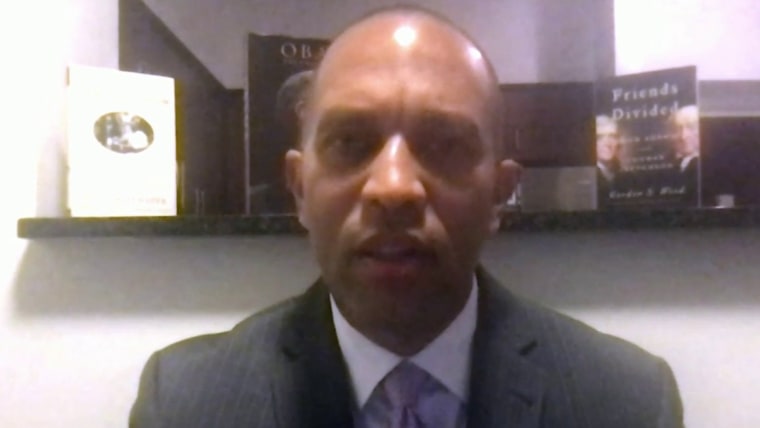President Joe Biden is finally feeling the heat. Faced with an infrastructure deal at risk of collapse and deadlocked budget negotiations that could shut down the government if not resolved before Sept. 30, Biden convened over a dozen lawmakers at the White House on Wednesday to overcome opposition to the measures within his own party.
Biden’s inability to draw a strong line has only emboldened those on the party’s right flank, who are taking advantage of an evenly split Senate to seize outsized power to stall legislation.
Unfortunately, his main strategy to quell the intraparty mud-slinging consists of caving to moderates’ ambiguous, ever-shifting complaints.
As NBC News reported Thursday morning, the White House seems to have given up hope that Biden’s signature $3.5 trillion budget package will survive obstructionist Senate Democrats Joe Manchin of West Virginia and Kyrsten Sinema of Arizona without major cuts. In fact, Biden all but invited Manchin to name his own price tag on the spending plan this week, despite that being certain to outrage progressives.
Biden’s inability to draw a strong line has only emboldened those on the party’s right flank, who are taking advantage of an evenly split Senate to seize outsize power to stall legislation. The conflict that now imperils Biden’s entire first-year agenda has been fueled at every turn by “centrist” lawmakers breaking with the majority of the Democratic Party, none more so than Manchin. For months, the entire party has governed only to the extent that Manchin has allowed it to, and not an inch further.
Manchin has grown increasingly comfortable as the Senate’s power broker since Democrats took control of Washington in January. Now he’s willing to blow up Democrats’ biggest bipartisan achievement — the infrastructure bill — to defend a mythological centrism that doesn’t represent the political center in today’s America; most voters support Biden’s budget plan.
Yet Manchin recently suggested Biden delay that undertaking until 2022, a transparent effort to put Democrats in a desperate negotiating position as midterm elections loom. That would mean Democrats would enter a brutal election campaign having failed to deliver on large swaths of Biden’s campaign promises. The result would be a bloodbath.
If Democrats want to get their party back under control, and start achieving their legislative goals, party leadership must draw a red line at Manchin’s self-serving disruption. Unfortunately, Democrats have proven far more hesitant to enforce a firm party position than their Republican counterparts. That fear of discipline has allowed rogues like Manchin to seize control of the agenda without fear of punishment while the rest of the party pays the price.
Democrats need look no further than across the aisle to see how a different approach could work. Nowhere is the willingness of today’s GOP to impose order on any member straying beyond the party line clearer than in its ouster of Wyoming Rep. Liz Cheney.
Cheney’s conservative bloodline — which runs through her father, former Vice President Dick Cheney — once ranked among the most respected and influential in the nation. Yet Cheney found herself unceremoniously dumped from GOP House leadership in May, stripped of her role as House Republican Conference chair, after her unwillingness to support the “big lie” that Democrats meddled in and ultimately stole the 2020 election from then-President Donald Trump.
Cheney may have cut a defiant tone after her ouster, but that didn’t make House Republican Leader Kevin McCarthy’s gambit any less effective in demonstrating that the GOP would make no exceptions in cracking down on Trump opponents. Since Cheney’s removal in May, the bubbling anti-Trump sentiment among House Republicans has largely vanished.
One of the few remaining Trump critics, Illinois Rep. Adam Kinzinger, faces the looming threat of his own removal from the party. Others, like former Michigan Rep. Paul Mitchell, saw the impossibility of existing as both a Trump critic and a Republican and voluntarily left the GOP instead of facing the heat of McCarthy’s political orthodoxy squad.
I’m not saying the Democrats should emulate the GOP march into groupthink authoritarianism. But Democrats — especially Senate Democrats — have been defined by their conspicuous unwillingness to enforce anydiscipline on wayward caucus members like Manchin.
The White House largely gave up pressuring Manchin after a brief and hastily abandoned effort early this year ended up with Vice President Kamala Harris politically bruised when Manchin publicly pushed back on critical news appearances Harris booked in his home state, leading Harris to back down. The event left the White House embarrassed and Manchin even more entrenched.
Since then, Senate Majority Leader Chuck Schumer has largely let Manchin cut his own path through the Democratic policy platform — regardless of how Manchin’s rhetoric is dooming the chance of Schumer being able to hold a Senate majority in 2022. Manchin’s media-ready antics risk putting Democrats in the humiliating position of spending the opening months of the midterm season explaining why Biden and a Democratic Congress were unable to unify and deliver on fundamental campaign promises, such as protecting voting rights from sustained GOP attacks and leading a historic reinvestment in American infrastructure and economic competitiveness.
Of course, pushing Manchin too hard could drive the West Virginian right out of the party, handing the Senate back to Minority Leader Mitch McConnell and the GOP. But while there’s a risk Manchin might bolt, inaction on widely popular and needed policy reform practically guarantees Democrats face a political wipeout in the upcoming elections. If Biden wants to avoid sacrificing Democrats’ hard-won 2020 victories, he needs to stand up to Manchin and bring the Democratic Senate back in line. Fast.
Severe acts like expulsion aren’t merited, aren’t productive and aren’t politically possible in any circumstance. Booting a Senator requires a two-thirds majority in a sharply divided chamber, and while Manchin’s acting out may be migraine-inducing, it doesn’t rise to the level of criminal misconduct, which is what that type of punishment should be reserved for. It also doesn’t rise to the level of censure, last applied to Minnesota Republican Sen. David F. Durenberger for engaging in financial misconduct.
But there are more realistic options, including one that would allow Biden to walk in the footsteps of a leader he has been compared to in the past, Lyndon B. Johnson. Journalist Mary McGrory once described the “Johnson treatment,” his literally in-your-face arm-twisting, as “an incredible, potent mixture of persuasion, badgering, flattery, threats, reminders of past favors and future advantages.”
Johnson’s screw-turning was preserved for posterity in a series of photographs from 1957 showing the then-Senate majority leader bearing down on his aging Rhode Island colleague Theodore Green. There is a reason Johnson’s tenure as majority leader is considered a master class in how to make America’s most independent-minded politicians fall in line.
Right now, Manchin is the Democrat doing the leaning. If Biden wants to restore control over his presidency — and the legislative agenda that will determine whether Democrats still retain control of either chamber of Congress by 2023 — he should acknowledge that his back-slapping hasn’t worked.
It’s time the White House reminded Manchin and his allies that there are political costs to undermining popular, long-overdue policies supported by broad majorities of Americans from both parties. Without strong and immediate leadership from Biden, the era of Democratic governance will be over before it even begins.
Source: | This article originally belongs to Nbcnews.com










